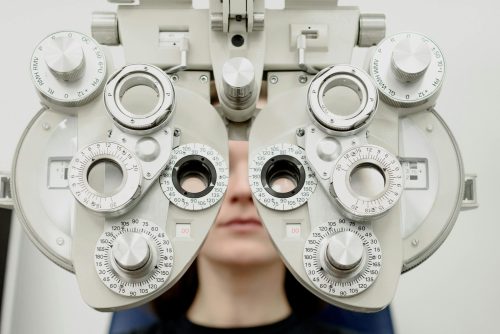Glaucoma is an eye condition caused by the buildup of fluid in the eye, increasing pressure and damaging the optic nerve. At Collins Eye Center, we prioritize early detection and treatment of glaucoma to prevent debilitating symptoms like blindness. Optometrists recommend regular eye exams for older adults, as they are at a higher risk of glaucoma.
Testing for Glaucoma
There are several types of glaucoma, and the most common is open-angle glaucoma. Open-angle glaucoma is asymptomatic and can go undetected without a medical exam, slowly causing vision loss. Angle-closure glaucoma is less common, but it progresses quickly and has symptoms such as severe eye pain, nausea, and blurry vision. Our optometrists conduct four types of glaucoma tests:
Tonometry
Tonometry is a test that measures interocular pressure. A flat-tipped probe is gently pressed against your eye’s surface to detect changes in pressure. Alternatively, the optometrist may perform a non-contact tonometry test. Air pressure is applied to your eye, slightly flattening the cornea, and the resistance is measured.
Ophthalmoscopy
Ophthalmoscopy is an optic nerve test that determines damage to the optic nerve. During this test, your eye doctor uses eye drops to dilate your pupil and examine the optic nerve using a special lens. If there are abnormalities on the optic nerve, optometrists conduct further tests to confirm whether you have glaucoma.
Perimetry
The perimetry test checks your field of vision to determine whether you have onset vision loss. During this test, your eye doctor reveals a series of light spots in different areas of your field of vision and asks you to indicate what you see. This helps your doctor determine the extent of glaucoma-related vision loss. If there is damage to your peripheral vision, may limit the number of lights you see.
Gonioscopy
During a gonioscopy, your eye doctor uses a mirrored contact lens to view the angle between your iris and cornea, where fluid drains out of your eye. You are at risk for glaucoma if you have a blocked drainage angle. Your eye doctor can tell what type of glaucoma you have from the results of the gonioscopy.
Treating Glaucoma
The primary goal of our glaucoma treatments is to lower interocular pressure, preventing further damage to your optic nerve. Our eye doctors may prescribe prostaglandin eye drops to increase liquid outflow in your eye, beta-blockers to reduce eye fluid production, or alpha-adrenergic agonists, which do both. If eye drops are not sufficient to reduce the pressure in your eye, our eye doctors may recommend surgical procedures, which may laser treatments, filtering surgery, or the insertion of drainage tubes.
Book an Appointment with Our Optometrist Today
Regular eye exams are necessary for early detection and treatment of glaucoma. The optometrists at Collins Eye Center use advanced diagnostic tools to detect signs of glaucoma. If diagnosed with glaucoma, our optometrists prescribe a suitable treatment depending on the extent of your condition. We follow your recovery keenly, helping prevent further progression of glaucoma. Schedule an appointment with us today for comprehensive glaucoma tests.


